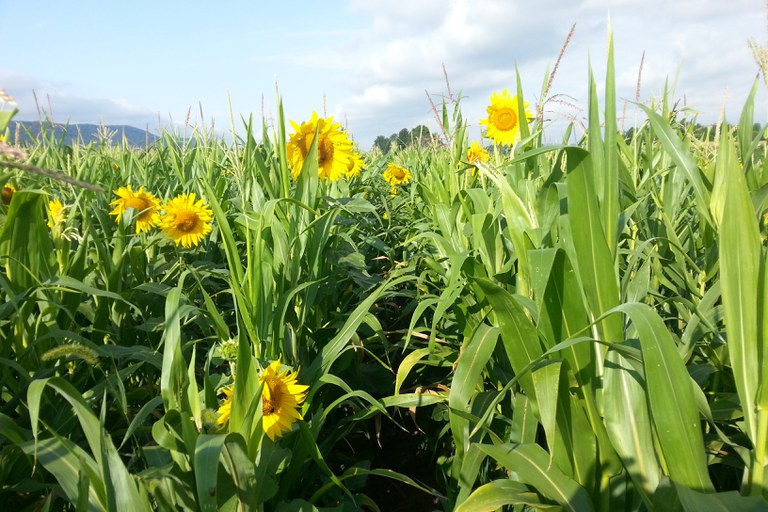USDA-NIFA Foundational Program 2016 - 2021. Award# 2016-67019-25209. PI John Tooker, Co-PIs: Armen R. Kemanian and Gregory Roth Polycultures and managed biodiversity can improve corn silage and wheat productivity, resilience to abiotic and biotic stresses, and the environment.

Polyculture at Rock Springs, PA in 2016. A silage mixture composed of 1/3 corn, 1/3, sorghum, and 1/6 of soybean and sunflower, respectively. Sorghum provides tolerance to water stress, soybean reduces the nitrogen demand, and sunflower and the other species provide habitat for beneficial insects among other benefits.
This project focuses on corn-based silage and wheat production, two major components of the annual phase of production systems in Pennsylvania and a large portion of the United States. The concept is to bring diversity to annual production systems without penalizing productivity. Crops for silage can be mixed as long as it is practical to plant them together, and there is no penalty for mixing wheat genotypes. Why not doing so then, and what are the actual benefits of biodiversity in this context? In this project, one graduate student will focus in abiotic stresses working under A. Kemanian and G. Roth, and another graduate student will focus on biotic stresses working under J. Tooker and G. Roth. We propose to study mixtures of corn, sorghum, forage soybean and sunflower and mixtures of different wheat cultivars.
"Poets -- and city folks -- love to romanticize agriculture, portraying it as some sort of idyllic state of harmony between humankind and nature. How far this is from the truth! Since Neolithic man [woman?] domesticated the major crop and animal species some 10-12 millennia ago, agriculture has been a struggle between the forces of natural biodiversity and the need to produce food under increasingly intensive production systems" (N. Borlaug 2002).
Borlaug's point accurately reflects the history of agriculture in industrialized nations up to the Green Revolution. To produce food, humans progressively modified plants, animals and their environment. These modifications have typically involved simplifying production systems, which in turn made ecosystems more vulnerable to environmental stressors. And it has been argued that lack of attention to these vulnerabilities lead to the collapse of civilizations unwittingly reliant on vulnerable environments (Diamond 2005). By historical standards, the advent of the industrial revolution, agricultural mechanization and low-cost agrochemicals, brought a global dimension to the negative effects of large-scale agriculture that could play out in short times scales. For, while high input and low diversity annual systems can produce a substantial amount of calories per unit of input, they are prone to nutrient and pesticide leakage and pests outbreaks. In short, to counter the forces of natural biodiversity, we simplified systems and unleashed a technological arms race to tamper the problems generated by these systems, with an escalating cascade of environmental impacts. It does not need to be so. Our project seeks to incorporate managed biodiversity while retaining high productivity of current systems and improving environmental integrity, striving for sustainable intensification.
USDA-NIFA Award# 2016-67019-25209. PI John Tooker, CoPIs Armen Kemanian and Gregory Roth

